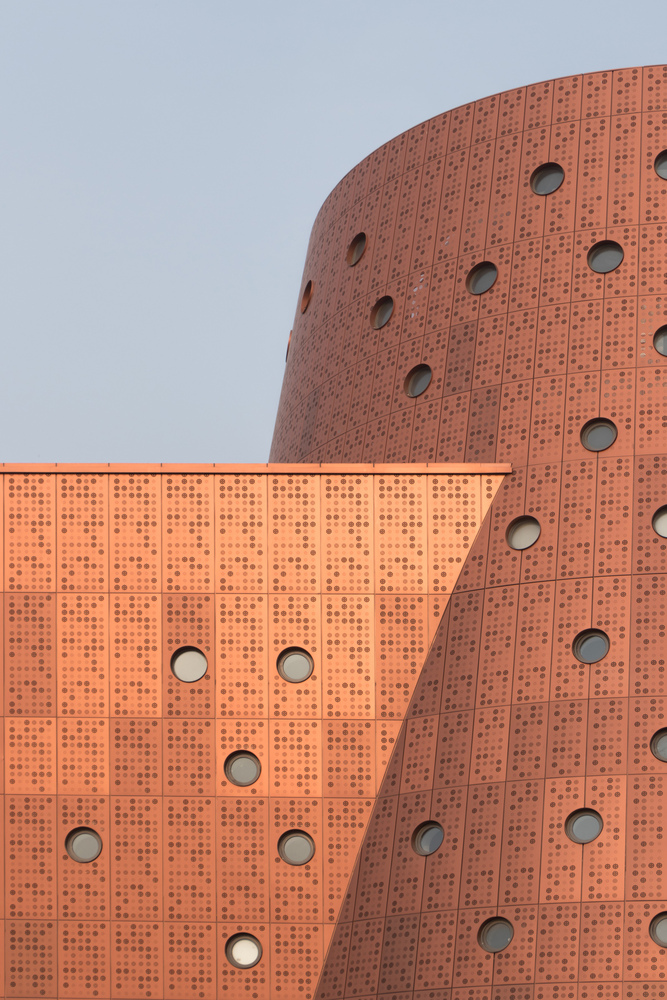Urban Stripes Klab Architecture
2013-12-13 01:00


“城市条纹”是一座公寓楼或“多卡托伊卡”,在希腊俗称为这类建筑。它位于库卡基,一个位于雅典市中心的社区,非常靠近贝尔纳·特斯库米(BernardTschumi)新建的雅典卫城博物馆和上个世纪有影响力的希腊建筑师泽内托斯(Zenetos)的旧啤酒工厂“Fix”。这一社区大多是住宅区,建于60年代和70年代,类型为“多卡托伊卡”(Polykatoikia)。
“Urban stripes” is an apartment building or a “polykatoikia” as it is commonly known in Greece this type of building. It is located at Koukaki a neighborhood in the centre of Athens very close to the new museum of Acropolis by Bernard Tschumi and the old beer factory “Fix” by Zenetos an influential Greek architect of the last century. The neighborhood is mostly residential, built during the 60’s and 70’s with the typology of the “polykatoikia”
© Panos Kokkinias
(Panos Kokkinias)


重新阐释这一类型学的要素,并从该地区的两座重要建筑“城市条纹”中,创造出一种新的城市外观,以适应当今时代的城市和社会条件。
Reinterpreting elements of this typology and from the two important buildings of the area “Urban stripes” create a new urban façade responding to the urban and social conditions of current times.
© Panos Kokkinias
(Panos Kokkinias)
last.jpg)

城市条纹是在雅典危机不明显的时候设计的,在危机最严重的时候就结束了。虽然它的设计没有顺应建筑泡沫时代的潮流,但高档豪华公寓并不是一座危机的建筑。这是一座相当灵活的建筑,为不同的钱包和需求提供解决方案,就像几十年前雅典的情况一样。当时,“多卡托伊卡”(Polykatoikia)是一种有趣的社会混合和混合功能的实验,通常遵循自下而上的财富等级,在一层分配办公空间,在底层分配办公空间,在中层、上层和地下室分配住宅。
Urban stripes were designed when crisis was not evident in Athens and it was finished when crisis is on its peak. Although it was not designed following the trend of a construction bubble era of luxury high end apartments it is not a building of the crisis. It is a rather flexible building that provides solutions for different wallets and needs as it was always the case some decades ago in Athens when “polykatoikia” was an interesting experiment of social mixture and mixture of functions usually following the hierarchy of wealth from bottom to top, distributing office spaces on the first floors, local retail on the ground floor, residential on middle, upper and basement floors.
© Panos Kokkinias
(Panos Kokkinias)


公寓的定义是根据他们的大小,位置,计划,截面和他们对卫城的看法。城市结构正在被过滤,隐私是重要的,因为密集的城市环境在该地区占主导地位。使用与Zenetos建筑和相邻建筑外观的阳台直接相关的线性关系,通过不同高度的线性开口设计,显示或隐藏不同的城市风景。与线性并列,悬臂式阳台作为体积。
Apartments are defined through their size, position, plan, section and their view to Acropolis. Urban fabric is being filtered and privacy is important as the dense urban environment is dominant in the area. Using linearity that creates a direct relation to Zenetos building and the balconies of the adjacent building façade is designed through linear openings on different heights that show or hide different pieces of the urban scenery. Juxtaposed to the linearity the cantilevered balconies act as volumes.
© Panos Kokkinias
(Panos Kokkinias)


今天生活在雅典市中心的人们,与1960年到1970年这个社区建设的时候有了很大的不同。隐私和安全是非常重要的。受控制的视图模糊了你不想看到的东西,允许你想看到的地方也很重要。噪音和污染改变了阳台的需求,由于雅典的气候,阳台对公寓的功能是必不可少的,但不再是过去那样的程度和尺寸。
Living in the centre of Athens today is dramatically different from when this neighborhood was built back in 1960-1970. Privacy and safety are very important. Controlled views obscuring what you don’t want to see and allowing where you want to see is important as well. Noise and pollution have altered the need of balconies which are essential to the function of an apartment due to the climate of Athens but not to the extent and the dimensions that used to be.
© Panos Kokkinias
(Panos Kokkinias)


在像雅典这样的灰色城市里,正面的白色确实很突出,但它也有助于夏季强烈阳光的反射。一楼将用于办公,因此,立面是不同的,为大楼创造了一个基地。背面的外观使用了不同的元素,被遗忘的背面的雅典。采用过去的形式如圆柱形楼梯,几乎错位的窗户“城市条纹”有着独特的现代重新诠释,几乎没有真正设计的雅典背面任意。
In a grey city like Athens the white color of the façade really stands out but it also helps to the reflection of the intense sunlight during summer. First floor is going to be used for offices and for this reason the façade is different creating a base for the building. Back façade uses different elements of the forgotten back facades of Athens. Using forms of the past like cylindrical stairway, and almost misplaced windows “urban stripes” have a unique modern reinterpretation of the almost arbitrary not really designed back facades of Athens.
© Panos Kokkinias
(Panos Kokkinias)


过滤那些完全被忽视的背面的必要但不情愿的观点是我们必须做的一项非常重要的任务。使用彩色叠层玻璃,我们提出了一个不同的观点,这些城市废墟,这突然变得有趣。
Filtering necessary but unwilling views to those totally neglected back facades was one very important task that we had to do. Using colored laminated glasses we proposed a different view to these urban ruins, which suddenly became interesting.
© Panos Kokkinias
(Panos Kokkinias)


每一层楼都是不同的,它的公寓适合不同的生活场景和需求。随着我们越来越高,雅典卫城和帕台农神庙的景色令人叹为观止。在5楼之后,由于法规的原因,我们不得不休憩,因此建造了一栋新建筑,建造了一套透明的顶层公寓和巨大的玻璃外墙,以探索与雅典卫城岩石的对话。这套顶层公寓由裸露的混凝土和玻璃制成,分为三层。
Every floor is different and its apartment answers to different living scenarios and needs. As we get higher Acropolis and Parthenon view is breath taking. After the 5th floor due to regulations we had to recess and so a new building, a penthouse has been created with transparency and vast glass façade to explore a dialogue with the Acropolis rock. The penthouse is made by exposed concrete and glass and is extended in three floors.
© Panos Kokkinias
(Panos Kokkinias)


在内部,公共空间正在被处理再次使用过去的元素,如马赛克地板和大理石硼砂,但它也是好玩的使用调色板的颜色,以区分每一层。
Inside, the common spaces are being treated using again elements of the past as mosaic flooring and marble bordures but also it is playful using a palette of colors that differentiate each floor.




last.jpg)





































Architects Klab Architecture
Location Veikou 37, Athens 117 42, Greece
Category Commercial Architecture
Architect in Charge Klab Architecture, Konstantinos Labrinopoulos
Design Team Enrique Ramírez, Veronika Vasileiou, Elena Skorda
Project Year 2013
Photographs Panos Kokkinias
























